VIM VIGOR DANCE COMPANY premieres Shannon Gillen’s Separati.
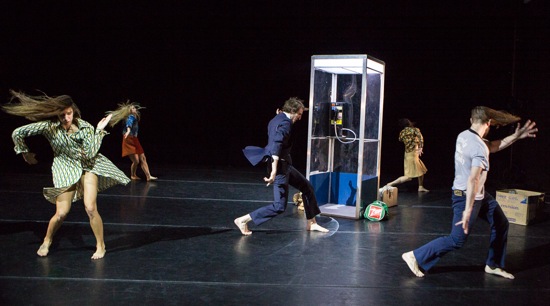
Members of VIM VIGOR DANCE COMPANY in Shannon Gillen’s Separati. (L to R): Lavinia Vago, Emma Whiteley, Jason Cianciulli, Laja Field, Martin Dûrov. Photo: Yi-Chun Wu
A Plexiglas phone booth sits marooned in the performing area of the Gelsey Kirkand ArtCenter’s 400-seat black-box theater, glowing eerily in Barbara Samuels’ lighting. As Shannon Gillen’s Separati for her VIM VIGOR DANCE COMPANY unfolds, I think of Edward Hopper’s paintings of bleak, deserted city streets, or of people in restaurants or hotel rooms who are together only in the sense of temporarily sharing the same space.
The five characters in this dance are stranded, but they can leave the vicinity of the phone booth at will and return—maybe now with a coat or with their hair combed. Periodically, the phone rings, and it’s not just the operator whose voice we hear. A scarily omniscient male voice—God’s or a shrink’s or their own fears—may tell one of them that the others know her secret, or advise another to calm down, that everything will be all right. The phone itself has a persona, able to hang threateningly in the air on what appears to be the usual flexible metal cord.
And everything is definitely not all right. At this intersection of present discomfort, memories, and visions of the future, rage and violence erupt, transform, vanish, erupt again. The score by dancer Martin Dûrov in collaboration with the choreographer hints at trains racing along, thunder, heavy footfalls, buried voices, radios beset by static. The strangeness of Gillen’s vision is evident in the first few minutes. A woman (Laja Field), her black hair concealing her face, slowly approaches another (Lavinia Vago), who also hangs her head and whose face is also invisible. When Field gets to her destination, she reaches out and yanks Vago’s short dress up (to inspect her? To shame her?). Yet within seconds, the two of them are dancing in unison, and shortly a third woman (Emma Whatley) joins them.
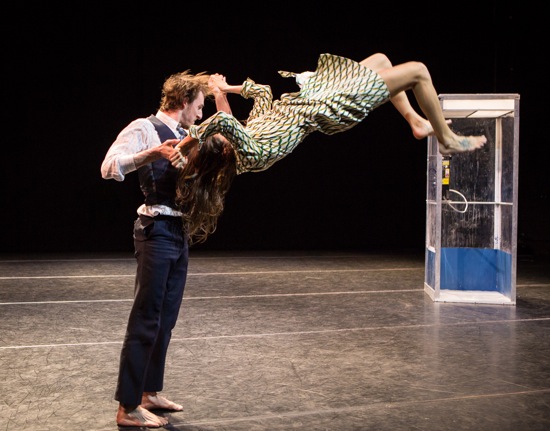
Jason Cianciulli and Lavinia Vago in Shannon Gillen’s Separati. Photo: Yi-Chun Wu
Gillen embraces human awkwardness, wildness, risk—all dark-toned by emotion. Her highly individual phrases of movement (made in collaboration with the dancers) has them thrashing and staggering, flinging their arms, twisting their legs together, wrenching themselves off balance, crashing to the floor, rolling, spinning. They seem out of control, even when we know they’re not. They plunge into a somersault as if they’re trying to avoid a truck that’s bearing down on them. They can swerve from fury into tenderness and vice versa at the drop of a hat.
Who are these people with their hair-trigger tempers? We’ll never know. Jason Cianciulli is wearing a three-piece, navy blue suit, while Dûrov sports jeans, a t-shirt, and a punky haircut; a beer can is occasionally in his hand. A relationship may exist between Cianciulli and Vago. The three women wear skirts or dresses. That everyone goes barefoot is odd and a bit jarring, but the decision may have been a practical rather than an aesthetic one. The ways in which these people wrangle with each other, lift or throw a partner, flip someone head over heels necessitate a degree of self-preservation.
Field and Dûrov, as well as Gillen herself, have worked in Berlin with choreographer Johannes Wieland, and have, like him, embraced a ferocious intensity both physical and emotional. The other four dancers have risen marvelously to the occasion. Watching them for almost the entire hour-long piece, the spectators around me barely move, unable to predict what will happen next in this way station for hallucinatory encounters. Is this staggering person drunk or only lost in rapidly shifting terrain of his her own making? Who is the instigator and who the victim in this kill-or-be-killed duet? What do the passages of vigorous dancing that people drop into and out of signify—the rituals of daily life? Did enemies just become friends? We seem to be seeing what might be fragments of different lives suddenly glued together. At times, performers freeze in mid-action, as if time has temporarily stopped for one of them. Footlights often give events the aura of a play; the phone booth performs its own dances by means of changing colored lights.
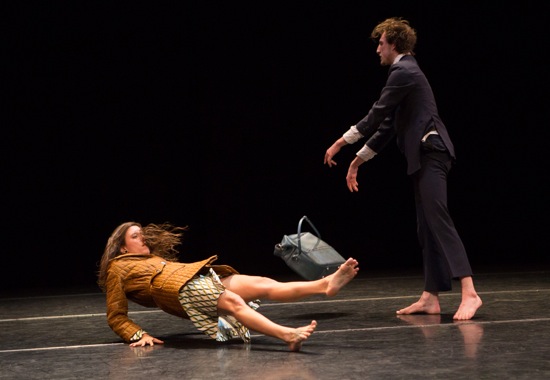
Jason Cianciulli, Lavinia Vago, and bag. Photo: Yi-Chun Wu
Gillen comes up with some brilliant ideas and devises some brilliant passage. In one scene, Vago enters, wearing a coat, and tosses her duffel bag at Cianciulli. He then throws the bag around in various ways, while she mimics the bag’s moves, becomes the object. He intensifies this by dragging her around by her coat and dropping her in various places (she’s limp); in the end he (terrifyingly) flips her over his head to the floor.
In another scene, just as a woman’s recorded voice says, “He made it almost fun,” Cianciulli helps Whiteley step into a not-very-large cardboard carton that’s been standing onstage, folds her down into it, and closes it up. What seems like a disturbingly long amount of time elapses before she emerges, staggering a bit and kicking one leg free of the box. “We’ve all done shameful things,” says the male voice.
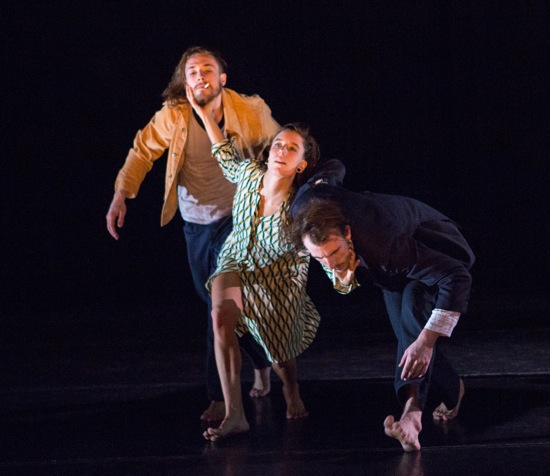
(L to R): Martin Dûrov, Lavinia Vago, Jason Cianciulli, and cigarettes in Shannon Gillen’s Separati. Photo: Yi-Chun Wu
Cianciulli, Dûrov, and Vago join in a close, ever-evolving tangle of a trio, during which two lit cigarettes are constantly passed to two mouths, then plucked away and redistributed. You lose any sense of who, if anyone, is in control of these complex and daring maneuvers.
The level of risk is high, and the performers—whether dancing, speaking, lip-synching, or being pitched through the air and hammered to the ground—rise to it magnificently. I have to say, though, that at some point, I thought Separati was ending. It was when Vago, standing downstage told us that she was alone and sick of this place, while behind her, Field and Whiteley echoed her gestures. “That’s it,” she said, and the lights went out. That wasn’t it, though. There was thunder and rain and wet hair, Field snaring her head and one arm in the black tights she’d just removed, she and Dûrov kissing in the phone booth, everyone staggering around.
In the end, Dûrov attacks everybody, one by one, and finally shoves all of them into the booth, as if he were making one last attempt to contain his demons. A powerful ending to a fascinating work. I admit, however, that some minutes before that, I’d begun to feel numbed by the many violent, unresolving encounters. It’s not that the dance was long, but it had begun to feel long. Perhaps the vastly gifted Gillen wanted us to feel the pointlessness of almost random hostility and the fragility of apparent conclusions.
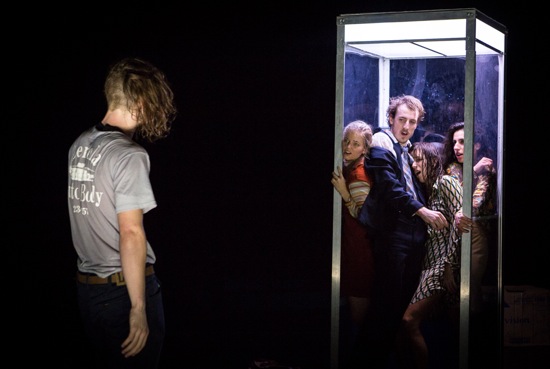
Martin Dûrov contemplates (L to R) Emma Whitely, Jason Cianciulli, Lavinia Vago, and Laja Field. Photo: Yi-Chun Wu

Deborah,
Your writing of the VIM VIGOR DANCE COMPANY’s performance of Separati is beautifully done. It makes me long to see the piece myself. But I wonder if the work can live up to your haunting, illuminating words. Thank you once again.
It does!